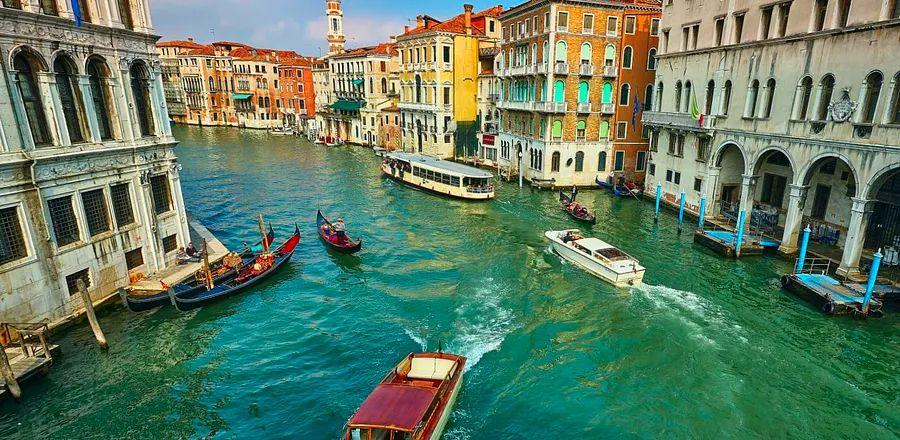Venice's New Visitor Entry Fee is Now Active—Here’s What You Should Know

Reaching Venice, Italy’s iconic floating city, has always demanded a bit more effort, whether by boat, bus, car, train, or plane—and starting April 25, it now also requires an additional fee on select days throughout the year.
In the autumn of 2023, the Venice city council approved a 5-euro entry ticket (approximately US$5.35 at current exchange rates) for day visitors. In November, the city announced the specific 29 days in 2024 when visitors will need to purchase a ticket to step foot on La Serenissima.
Entry Fee Dates for Venice in 2024
- April 25–30
- May 1–5, 11–12, 18–19, 25–26
- June 8–9, 15–16, 22–23, 29–30
- July 6–7, 13–14
What is the cost of Venice's new entry fee and who is required to pay it?
During the specified dates, from 8:30 a.m. to 4 p.m., a 5-euro entry fee will apply to all individuals aged 15 and older entering Venice, excluding residents, property owners, university students, and employees working in the city.
How will Venice’s new entry fee function and what measures will be taken for enforcement?
Hotel guests, who are already subject to a nightly tourist tax, will be exempt from this fee. However, they must still register online in advance or obtain a QR code through their hotel.
To pay the fee, day visitors must visit http://cda.ve.it, where they can obtain a QR code to present to authorities during checks, as per the city council's recent update. This QR code serves as proof of payment or confirms an exemption, and visitors must carry it at all times, according to the city’s guidelines.

Photo by Jaroslav Moravcik/Shutterstock
A move to combat overtourism
“We must demonstrate to the world that, for the first time, action is being taken for Venice,” stated city mayor Luigi Brugnaro during a council meeting on September 12. In this context, “action” refers to a ticketed pilot program designed to assess the impact and logistics of an entry fee, with the hope of addressing Venice's long-standing challenges with overtourism.
The entry ticket's approval comes after over two years of discussions, debates, and delays, alongside a UNESCO recommendation to place Venice on the List of World Heritage in Danger. On September 14, UNESCO decided not to include Venice on this endangered list, which consists of around 55 sites facing threats like war, natural disasters, climate change, and/or uncontrolled tourism. Although Venice has once again been spared, it is not the first instance of its UNESCO protected status being at risk.
Since the beginning of the 21st century, Venice has seen a consistent increase in visitors, with 2019 breaking all previous records and 2023 on track to potentially surpass those numbers. In 2019, nearly 13 million tourists flocked to the historic city, according to the City of Venice and Italy’s National Statistics Institute (ISTAT), vastly outnumbering the city's 49,665 residents. This isn’t new—Venice has been inundated with tourists for decades. After significant protests from locals, environmental advocates, and lovers of Venice, the Italian government prohibited large cruise ships from the city’s historic core in 2021. However, this has not eliminated the daytime crowds; they still gather in large numbers.
Narrow calle (streets) and extensive queues to enter St. Mark’s Basilica and the Doge’s Palace have become defining features of the Venetian experience. During the peak season, from March to October, mornings at Stazione Santa Lucia, Venice’s train station, can resemble Grand Central Station at rush hour or the frantic moments before a Harry Styles concert, as visitors rush to Rialto and San Marco in a tight single-file line.

Photo by Pyty/Shutterstock
Tips for escaping the tourist crowds in Venice
“Venice offers so much more: its artisans, cuisine, museums, art, music, boats, and a multitude of other wonders,” says Monica Cesarato, a culinary guide in Venice. “I truly believe that we can reduce tourist numbers by educating visitors rather than imposing taxes on them.”
There are indeed many ways to explore beyond the tourist hotspots in Venice.
Cesarato added, “Today, many people visit Venice just to snap a selfie and check it off their bucket list. We need to use the tools at our disposal, like social media, to educate them about the city before they arrive. Once visitors understand how much there is to experience in Venice and realize that one or two days are insufficient to uncover all its wonders, they’ll want to stay longer, which will reduce the number of day-trippers.”
With the entry fee now implemented, it’s clear that this is not a comprehensive solution to the long-standing frustrations of residents. It has also raised questions about whether there will be a cap on daily reservations (the city council insists there won’t be) and concerns about whether it will genuinely alleviate crowding, potentially lead to bottlenecks, or, worse, turn Venice into a sort of theme park.
“We are . . . conscious of the pressing need to establish a new equilibrium between the rights of those who live, study, or work in Venice and those who visit,” said deputy mayor Simone Venturini in an email. “This is why we require innovative flow management at specific times and on certain days to help mitigate the effects of daily tourism.”
This article was first published in September 2023 and was updated on April 26, 2024, to reflect the latest information.

1

2

3

4

5
Evaluation :
5/5